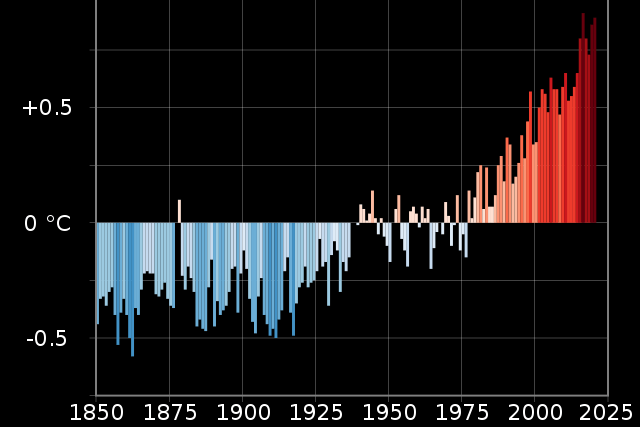
Scientists predict that our warming planet is likely to surpass the key temperature limit of 1.5 degrees Celsius (1.5C) for the first time in the next few years.
The chances of exceeding this threshold have risen to 66% due to ongoing emissions from human activities and the potential occurrence of an El Niño weather pattern later this year.
Passing the 1.5C limit would mean that the world is 1.5C warmer than it was in the second half of the 19th century, before the significant increase in fossil fuel emissions from industrialisation. Even a temporary breach of the limit is concerning, as it signifies that global warming is accelerating rather than slowing down.
The target of 1.5C has become a symbolic figure in global climate change negotiations, with countries pledging to make efforts to limit temperature increases to that level under the 2015 Paris Agreement. Exceeding 1.5C consistently for a decade or two would result in more severe impacts, including longer heatwaves, intensified storms, and increased wildfires.
However, surpassing the limit in one of the upcoming years does not necessarily mean that the Paris Agreement’s goal has been broken. Scientists emphasise that there is still time to restrict global warming by significantly reducing emissions.
Since 2020, the World Meteorological Organisation has been estimating the chances of breaching the 1.5C threshold in any given year. Initially, the likelihood was below 20% for the next five years, but it has now risen to 66%, indicating a greater probability.
The percentage does not directly measure the world’s temperature but serves as an indicator of how much the Earth has warmed or cooled compared to the long-term global average. Scientists use average temperature data from the period between 1850 and 1900 as a reference for pre-industrial levels.
While experts previously considered a 2C increase as the threshold for dangerous impacts, they revised this estimate in 2018, recognising the calamitous consequences of surpassing 1.5C.
In 2016, the warmest year on record, global temperatures were already 1.28C higher than pre-industrial levels. Researchers are now 98% certain that this record will be broken before 2027. They also believe that the 1.5C limit will likely be surpassed for the first time within the next few years.
“We really are now within reach of a temporary exceedance of 1.5C for the annual mean temperature, and that’s the first time in human history we’ve been that close,” said Prof Adam Scaife, head of long range forecasts at the Met Office, who compile the data from weather and climate agencies around the world.
“I think that’s perhaps the most stark and obvious and simplest statistic that we’ve got in the report,” he told a news conference.
However, maintaining temperatures at or above 1.5C for 20 years would be necessary to definitively state that the Paris Agreement threshold had been breached.
“This report does not mean that we will permanently exceed the 1.5C level specified in the Paris Agreement which refers to long-term warming over many years,” said WMO Secretary-General Prof. Petteri Taalas
“However, WMO is sounding the alarm that we will breach the 1.5C level on a temporary basis with increasing frequency,” he said.
Two key factors contribute to this potential breach: ongoing high carbon emissions from human activities, which continue to rise despite a temporary decrease during the COVID-19 pandemic, and the expected occurrence of El Niño, a climate phenomenon with global implications. The additional heat brought by El Niño to the surface of the Pacific Ocean is likely to contribute to a new temperature high.
Nevertheless, there is still uncertainty regarding the onset and scale of the El Niño event.
“It’s worth noting that a lot of our forecasts that are being made now for the El Niño that we think is developing this winter, are showing pretty big amplitude,” Prof Scaife told reporters.
“But to actually predict the magnitude, or a subsequent event within the five-year period, we can’t give the exact dates of that beyond this one year ahead, so it could be in three or four years from now we get to two and a half degree El Niño and that might be the one that does it. “
The Arctic region is projected to experience more significant warming compared to other areas, with the temperature anomaly expected to be three times larger than the global average over the next five northern hemisphere winters. Northern Europe, including the UK, is also expected to experience increased rainfall between May and September over the next five years, according to the report.
These predictions highlight the urgent need for enhanced efforts to mitigate climate change and reduce greenhouse gas emissions. By taking decisive action, there is still a chance to limit global warming and minimise the adverse impacts on our planet and future generations.
——————————————————————————
At Natural World Fund, we are passionate about stopping the decline in our wildlife.
The declines in our wildlife is shocking and frightening. Without much more support, many of the animals we know and love will continue in their declines towards extinction.
When you help to restore a patch of degraded land through rewilding to forests, meadows, or wetlands, you have a massive impact on the biodiversity at a local level. You give animals a home and food that they otherwise would not have had, and it has a positive snowball effect for the food chain.
We are convinced that this is much better for the UK than growing lots of fast-growing coniferous trees, solely to remove carbon, that don’t actually help our animals to thrive.
This is why we stand for restoring nature in the UK through responsible rewilding. For us, it is the right thing to do. Let’s do what’s right for nature!
Support our work today at https://naturalworldfund.com/ and join in the solution!

